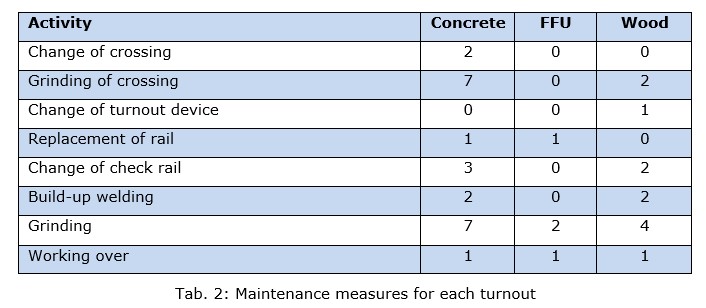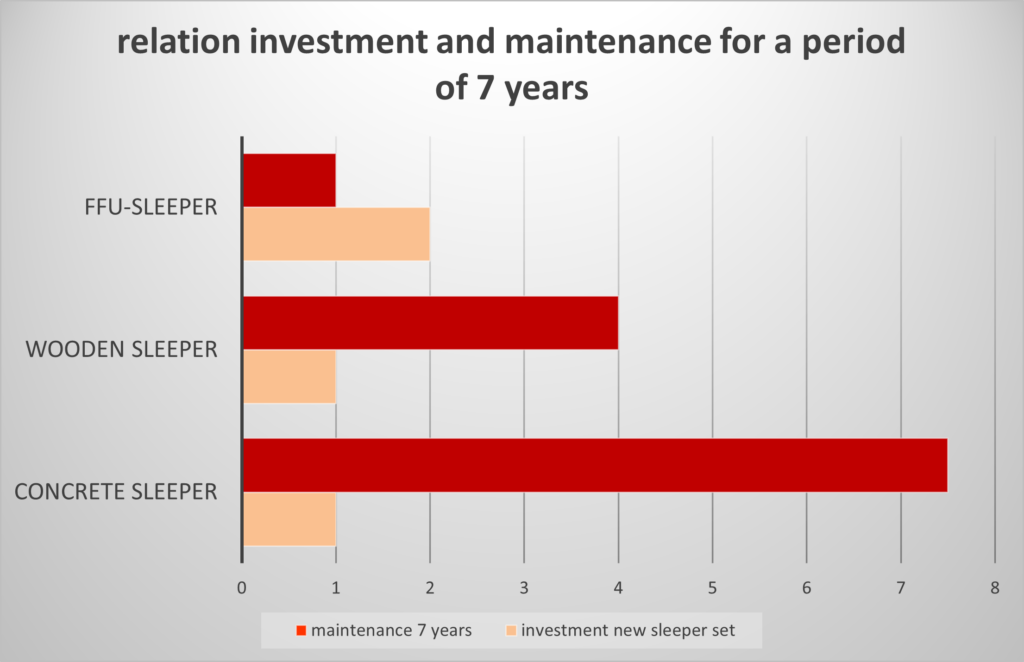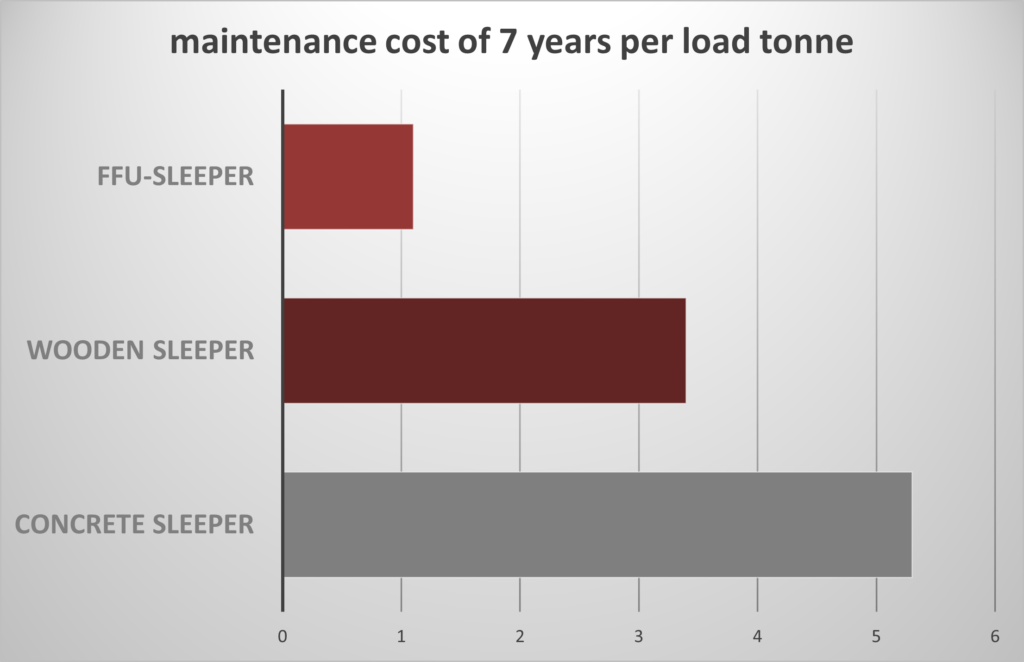Günther Koller
Sekisui’s synthetic wood sleepers, made from fibre-reinforced foamed urethane (FFU), have been used on the DB route network since 2011. With more than 75,000 turnouts on the Deutsch Bahn (DB) network, there is significant potential to use FFU sleepers if it can be shown that they offer worthwhile benefits, particularly in respect of maintenance and sleeper life.
To assess this, measurements were gathered for four turnouts during routine operation and evaluated. To this end, proof of the comparability of three turnouts at Würzburg Hauptbahnhof and one turnout at Bahnhof Hinterzarten was provided at the outset. The turnouts were examined in respect of location, wear, behaviour during the passage of vehicles, and the necessary maintenance measures previously carried out. This was done using Krabbe measurements, the sleeper height measurement device, the previous turnout inspections and the RAILab measurements. The long-term position of each turnout was to be assessed based on these findings. The wear of each turnout was evaluated based on measurements obtained using the ripple measurement device 1200, the railhead measurement device, the crossing measurement device and visual testing (VT).
To investigate turnout behaviour during the crossing of a rail vehicle, a 3D video measurement was used and the deformation behaviour of the turnout under load was evaluated. Maintenance measures carried out during recent years were derived from the turnout inspections and resulting notifications and were considered in connection with the measurements.
The results were critically examined and evaluated in close cooperation with the Technical University of Munich. Emphasis was placed upon the transparent and reproducible documentation of these evaluations, since several measurements were to be compared and the video measurements contained a large amount of information about the behaviour of each turnout under load.


Turnout types
The turnouts studied here fall under category v<160km/h.
The parameters of the simple turnout 54-500-1:12, the type of turnout studied here, are:
- Geometric length of 41.594 metres
- 98 turnout sleepers with a total length of 302 metres
- Weight of a concrete sleeper set: 46.8 tonnes
- Weight of an FFU synthetic wood sleeper set: 9.3 tonnes
- Weight of a padded concrete sleeper set: 47.6 tonnes
- Weight of a wooden sleeper set from 8.1 – 11.6 tonnes
The different sleeper properties are as follows:
Concrete turnout sleepers are the standard type of turnout sleepers used by DB. The rails are generally fixed in place using the W-superstructure. The weight of a sleeper without fastenings is 155kg/m. During the period of operation of a concrete sleeper, there occurs only a slight interlocking of the ballast with the sleeper.
The service life of a turnout with concrete sleeper is about 30 years.
Padded concrete sleepers are used by DB in the case of high speeds or small radii. In contrast to unpadded concrete sleepers, these sleepers allow for the minimisation of ballast abrasion. This has a positive effect on the service life of the ballast.
Concrete sleepers with elastic padding must be separated and disposed of separately to regular concrete sleepers.
The density of the FFU synthetic wood sleeper, which is 740kg/m3, is represented as 74. To produce an FFU 74 sleeper, the continuous strands of fiberglass that act as reinforcement are compressed with polyurethane under pressure.
Sleepers made of FFU 74 have been used on the Japanese railway network for over 40 years and, according to the Railway Technical Research Institute of Japan (RTRI), are expected to have a minimum service life of 50 years.
Artificial wood sleepers permit indentations to be formed by the ballast, as in regular wood.
Wood sleepers have been used in Germany since the inception of railway technology and have proven their usefulness over time. Today, wood sleepers are made from hardwood such as oak or beech.
Since 2002, the planned useful life of impregnated beech sleepers has been around 15 years due to creosote content being limited to 10%. If the sleepers cease to be impregnated in the future, the time in situ is expected to be another 3-5 years.
Because of the softness of wood in comparison to concrete, the ballast is able to interlock with the sleeper.
Wood sleepers must be disposed of separately due to impregnation. Artificial wood sleepers can be completely recycled after the end of their service life.


Measurements using digital image correlation
In addition to the usual measuring systems, digital image correlation (DIC) was used to examine the various sleeper types used in crossings. DIC is an optical measuring method that can be used to calculate displacement, velocity, and acceleration.
The measured values are obtained by calculating 3D coordinates from individual images or image series over a specified time interval. The recording of images is carried out using individual cameras, stereo camera systems, or multi-camera systems.
DB notifications
DB uses several types of maintenance notifications, examples of which are shown below.
An M1 notification is a request for maintenance. A maintenance request can be registered at any time and does not result from an inspection. Maintenance requests may only be used in cases where there is no disruption to routine operation.
An M2 notification is a malfunction report. It requires the maintenance team to ensure the restoration of routine operation by means of a targeted repair measure. The damage or defect must be repaired immediately or within a certain deadline, depending on the classification of the fault. In general, a malfunction report must be eliminated within 14 days. A malfunction report always influences operating processes and thus also incurs costs.
An M4 notification results from an inspection. It requires a follow-up service to be carried out to eliminate the finding. Depending on the severity of the finding, disruption to routine operation may occur during the elimination process.
The notifications issued for the examined turnouts over the last six years are as follows.

Comparison of DIC measurement results
All of the measurements for the concrete turnout indicate a tendency for the tip of the crossing to lift off at sleepers 3 and 5. The crossing at sleeper 4 remains in its original position. In comparison, in the FFU turnout, the transitions between the measuring points are more fluid and the values for the tip remain constant. Due to the lower weight of the FFU 74 sleeper compared to the concrete sleeper, the superstructure is more dynamic.

Figure 8 shows the different deflection curves for the wood sleeper (yellow) and the FFU threshold (orange), which bend in a parabolic shape. In contrast, the concrete sleeper (blue) and the padded concrete sleeper (grey) are deflected in a rather linear fashion.
Conclusion
Following evaluation of the sleeper height measurements, it was possible to confirm a parabolic deflection curve for the FFU sleepers and a linear deflection curve for the concrete sleepers. The turnout with the padded concrete sleeper behaves similarly to the concrete sleeper without padding.
However, the settlement of the padded concrete sleeper is slightly greater due to the padding. In the case of the wood sleeper, a certain degree of biological decay is also evident in the deflection measurement. Nevertheless, the wood sleeper shows a very elastic superstructure behaviour. The wood sleeper and the FFU sleeper are more flexible than the concrete sleepers with or without padding.

The type and quantity of maintenance measures carried out in the period from 2015 to 2021 can be found in the following table.
The number of necessary maintenance measures carried out over the last seven years on the concrete turnout vs. the FFU turnout lend themselves well to comparison, since the time in situ is almost identical. The concrete turnout required around 19 more repair requests than the FFU turnout. A total of 12 repairs were required to be carried out on the wood turnout due to the long time in situ.
The sleeper sets for the wood turnout and the padded concrete turnout cost approximately the same. The sleeper set with concrete sleepers is the most cost-effective. The sleeper set for the FFU turnout is slightly more than twice the price of the concrete sleepers.

The maintenance cost data show that the concrete turnout costs the most money after installation. During the last 7 years, i.e., the time in situ under consideration, the maintenance costs of the concrete turnout significantly exceeded the acquisition costs and maintenance costs of the FFU sleeper combined. The wood turnout generates about half of the maintenance costs of the concrete turnout, even though it has already been in situ for far longer. The FFU artificial wood turnout generates maintenance costs amounting to about a quarter of those for the wood turnout.
If, based on the above observations and number of maintenance measures (Tab. 2), one was to make a speculative estimate of the maintenance costs, these could possibly be as shown in the following figures:
Evaluation of the DIC measurements provides insights into the behaviour of turnouts during train crossings. The FFU turnout offers several positive characteristics in respect of dynamic movement.
The FFU sleeper material is softer and more elastic than that of the concrete sleeper, because of which the load is distributed over a longer distance. In addition, the weight of the FFU sleeper is lower, meaning that the sleeper can lift off more easily and thus transitions more smoothly into the lift-off wave. The lift-off wave of the FFU turnout remains at a constant high level.
As such, the investigation shows that the turnout with concrete sleepers does not move as dynamically as the turnouts with FFU sleepers, wood sleepers, and padded concrete sleepers, and is therefore more maintenance intensive. The concrete sleepers are the cheapest to purchase, the wooden sleepers are cheaper to maintain due to an elastic superstructure, and the FFU sleepers are the most economical overall over their entire service life.



